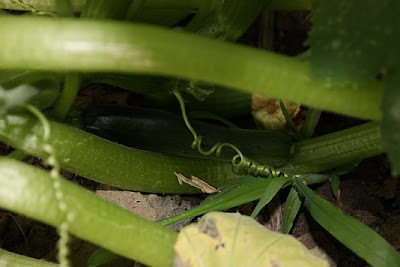 could happen!
could happen!
Lemon yellow cucumber is doing a little bit better. It's in the same bed, my hottest bed, and it is loaded with blossoms. I think I may even see the beginnings of some baby cukes, but I'm n ot sure yet.
ot sure yet.
 ot sure yet.
ot sure yet.
Dragon's Egg cucumber is a smaller plant than Lemon Yellow which is possibly related to being in less sun. Regardless, it is a bit farther along. Definite baby dragon's eggs on this one. It had some help in the pollination department. It's looking a little pale here. Looks like it's getting some worm tea for dinner tomorrow.
Chinese Yellow is my other cuke I am growing this year. It is struggling which is not surprising as it is growing in the wilds. The wilds is an area of my garden that is typically neglected, partially because the hose doesn't reach there and partially because of the skunk that lives in the woodpile.
The wilds used to be mostly shade as well. Then last week, Com Ed came in and lopped a massive limb off the apple tree for no apparent reason. It was nowhere near the vicinity of their power lines. Anyway, the end result was less apples and more light, enough now to allow several of varieties of vegetables to either show their stuff or suffer a slow, neglected death. Chinese yellow cuke is losing the battle. I think it's potato bugs chomping on it. They are completely ignoring the lemon cuke next to it which is interesting. Something to note for next year.

White squash is also growing in the wilds. It seems to be doing OK, despite being in shade a lot of the day. It has had a couple of male blossoms this week which were big and healthy looking. I'll try some hand fertilization if a girl blossom shows up.

I've never tried honeydew melons before but my daughter really wanted to try them this year. I forgot which variety this is, but after doing nothing for weeks, it seems to have figured out, the heat isn't coming. It has finally started to grow and blossom. It has fencing around it to keep the dog out of it. The toads like to hang out around it and the dog likes to harass the toads.
I had extra melon seed so I stuck one in the hanging tomato planters. It grew and has also blossomed. There are several problems with this arrangement which I'm sure you don't need me to explain. I'll just let you gaze in awe at the silly mistakes that can occur in the garden when one is bored.
Finally, the thread wouldn't be complete without a picture of a zuke. I am not fond of zucchini. I think I can trace it back to the zucchini pancakes my evil sister used to request of my grandma. It could also be the propensity for this plant to be one day from perfect on Monday and on Tuesday to be bloated past all hope of tastiness.
This is the only zuke in my garden. I planted it in the farthest corner of the wilds directly in front of the skunk's woodpile. It already has zucchini on it. Figures.



































